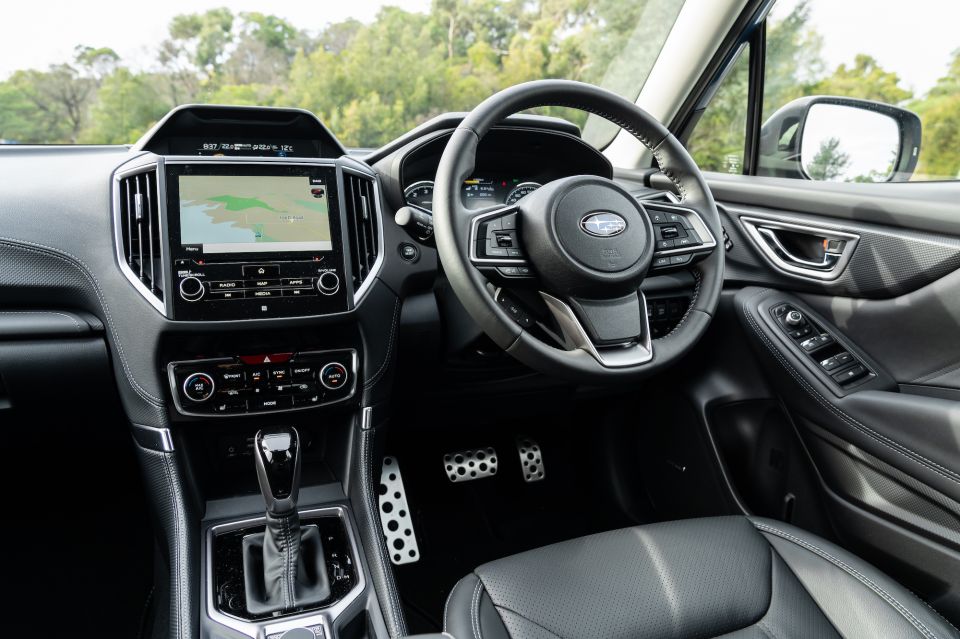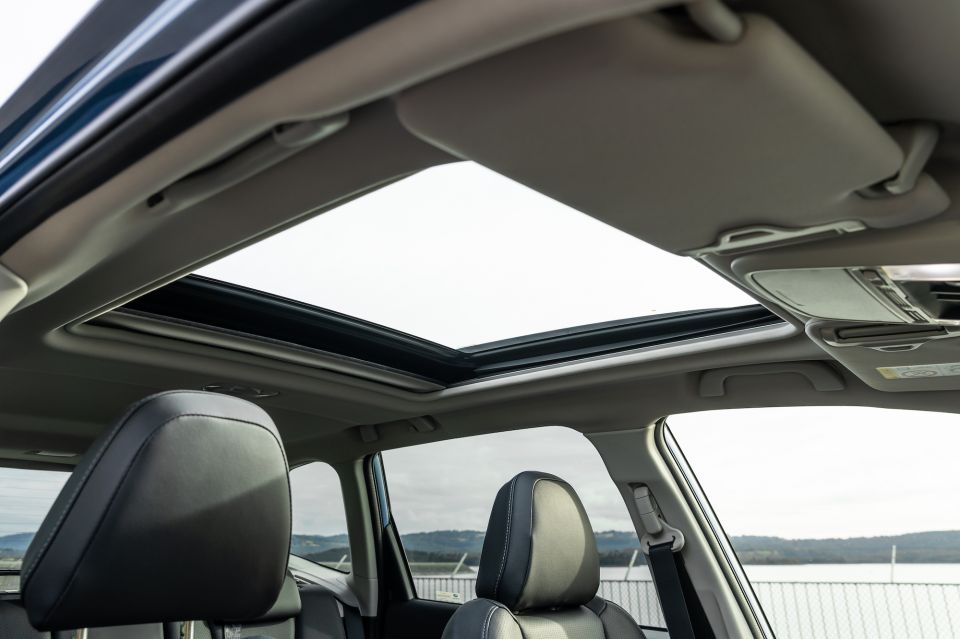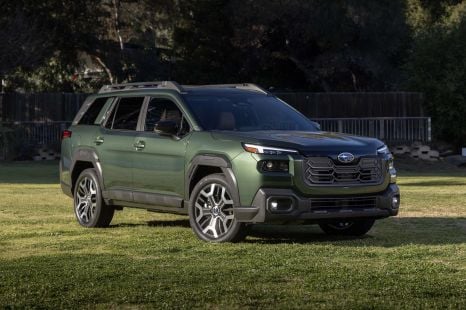

Alborz Fallah
3 Days Ago
The Subaru Forester is an appealing mid-sized SUV overall, but the new hybrid version is neither fun nor frugal enough to offset its price premium.



Senior Contributor
New from
$34,690
excl. on-roads

Senior Contributor
New from
$34,690
excl. on-roads


Senior Contributor
New from
$34,690
excl. on-roads

Senior Contributor
New from
$34,690
excl. on-roads
Quickly see how this car stacks up against its competition. Select any benchmark to see more details.
Take advantage of Australia's BIGGEST new car website to find a great deal on a Subaru Forester.
Market leader Toyota’s rapid expansion of its hybrid range has proven highly successful, with the RAV4 skyrocketing to class leadership in its latest incarnation.
So Subaru’s decision to follow suit and launch a fuel-sipping petrol-electric Forester derivative makes a world of sense, and even with fuel prices being low right now, should be welcomed.
However, Subaru’s first attempts at this driveline type in Australia look a smidgen underdone when you analyse the likely fuel savings and offset it against the price impost. Perhaps there’s more to the story?
While the petrol-electric Subaru Foresterrange kicks off at $39,990 before on-road costs for the base model, the flagship Hybrid S tested here costs $45,990 before on-road costs, or about $50,800 drive-away.




This means a $3000 higher sticker price than the range-topping ($42,990) Forester 2.5i-S petrol-only model that until recently served as flagship, and has the same list of features as the Hybrid S.
On the outside you get 18-inch alloy wheels, chrome-look door handles, auto-dipping and folding side mirrors, privacy glass on the rear windows, roof rails, dusk-sensing LED headlights, LED daytime running lights and tail lights, rain-sensing wipers, and a powered tailgate.
Comfort features include dual-zone climate control with rear vents, a proximity key and starter button, leather seat trim, heated and powered front seats (with memory for the driver), and a sunroof.




The infotainment system comprises an 8.0-inch touchscreen, digital radio, Apple CarPlay and Android Auto, factory satellite navigation, a CD player, two front USB points, Bluetooth phone and audio streaming, voice recognition powered by Siri if you’re an Apple user, and a Harman/Kardon audio system with eight speakers.
Yes. Crash-tester ANCAP awarded the Subaru Forester five stars in 2019, including scores of 94 per cent for adult occupant protection, 86 per cent for child occupant protection, 80 per cent for vulnerable road user protection, and 78 per cent for safety assist functions.
Standard equipment includes seven airbags, a facial recognition camera to detect driver drowsiness or distraction, and camera-based autonomous emergency braking designed to work in drive and reverse. It also operates at highway speeds, and can theoretically detect vulnerable road users such as pedestrians and bikes.




There’s also a lane-departure alert and emergency lane-keeping assist (steering intervention) system, active cruise control, and blind-spot monitoring, plus a surround-view camera display that shows a reverse view on the centre screen, and can also show you a forward view or kerbside wheel view in the smaller screen atop the dashboard.
ANCAP tested many of these safety functions under controlled conditions and they largely worked as intended. Read more on that here if you want to know more.
Spacious and bright are the first two words that spring to mind. The thin A-pillars, and big rectangular side windows, mean outboard visibility is excellent. Throw in the sunroof and you feel closer to the outdoors than in many competitors.
Material quality is okay, with some soft plastic and dimpled faux leather touch points breaking up the monotony, and the build feels typically robust. There are ample seat and wheel adjustments, meaning the ergonomics are sound, although the plethora of buttons adorning the steering wheel feel a smidgen like information overload.
The centre stack is dominated by that crisp and bright touchscreen. The user interface is simple to work out. Above this is a smaller screen showing camera views, or off-road (pitch angle, torque flow) and hybrid data.
Scrolling through this screen via the wheel buttons isn’t particularly intuitive.




One great idea is the facial-recognition camera-based presets system. Once you have ‘saved’ your face under a profile, the car recognises it’s you clambering into the driver’s seat and can change your seat settings, mirror angle, last used climate control temperature, and instrument display options to match what you had previously.
Storage space is pretty good, with a decent centre console, big door bins, and a sunglasses holder in the roof. I also like the sun visors that have an extending plastic piece that helps you really shut out the dawn or dusk glare.
The back seats offer vast legroom, headroom and shoulder room. I’m 194cm and was quite comfortable behind my own seating position. As I mentioned earlier it’s also very easy to see out, and the low window-line is quite kid-friendly. Amenities include two ISOFIX anchor points, three top-tethers, sectioned seatback pockets, rear air vents, and two rear USB points (meaning there are four in the cabin overall).
These seats fold flat via clever pulleys situated in the boot. Said boot also has four take-away hooks, an electric tailgate, a 12V socket, and a sliding parcel cover. The hybrid battery does not impinge on the boot space, which is a fairly generous 509L, although unlike petrol-only Foresters there’s no full-sized spare wheel, or even a temporary one. Instead you make do with a puncture patch/repair kit and an air compressor.




Until now the sole engine option in the current-generation Forester has been a 136kW/239Nm 2.5-litre naturally aspirated flat-four.
The hybrid tested here pairs a 100kW/196Nm 2.0-litre engine with a 12kW/66Nm permanent-magnet AC synchronous electric motor, a small-capacity lithium-ion battery pack, and a CVT transmission.
In theory, the motor powers the car’s ancillaries at the traffic lights, and gives you silent and smooth electric impetus when taking off or in reverse. From there the motor assists the petrol engine and converts captured brake and kinetic energy into charge for the small battery, which in turn is what powers the motor.
Unlike the Toyota RAV4, the Forester does not always respond to a jab of the start button in electric silence. Sometimes the high-revving idle of the engine is what greets you, if the ‘self-charging’ battery is low.
While you can roll off the line electrically, as soon as you apply even slight throttle pressure the petrol engine kicks in.
The petrol engine and small motor combination don’t have an awful lot of power for a 1642kg SUV, so your progress even in the throttle-sharpening and transmission-stepped-ratio-remapping Sport mode, is stately. I timed a 0-100km/h run of 10.5 seconds, and that was only with one occupant.
To its credit, the car can run at low speeds as an electric vehicle for short periods as long as you aren’t using the throttle – think looking for a park at a shopping centre on a normal weekend. If you’re travelling at high speed under petrol power and lift off, for instance down a hill or preparing to slow down, the engine does decouple and the car free-wheels using the hybrid battery.
Given the $3000 price premium over the Forester 2.5i-S, you’d expect some good fuel savings. But because the hybrid system has a small motor and low-capacity battery, it doesn’t take over from the petrol engine as much as the Toyota system does. Let alone the Mitsubishi Outlander PHEV’s even more advanced system.
The 2.5-litre petrol Forester has a claimed combined-cycle fuel consumption figure of 7.4L/100km, whereas the hybrid’s claim is 6.7L/100km, both using 91 RON. That’s a modest nine per cent superior economy for the hybrid.
Using the combined-cycle figures means saving 0.7 litres for every 100km, 7 litres per 100km, 70 litres for each 10,000km, and 700 litres per 100,000km.
If fuel is $1.20 per litre over the journey then you save $840 every 100,000km. If fuel jumps to $2 per litre then you’ll save $1400 every 100,000km.
Either way it’s a long way to go before you offset that $3000.
But in urban routes where the motor and battery are more active, that fuel saving increases to 19 per cent, so if you’re a stop/start city slicker you can expect to save about 15-20 per cent on your fuel bills.
The flip side? On highways, fuel use between the hybrid and non-hybrid is almost identical: 6.3L/100km vs 6.2L/100km. That’s because at high speeds the petrol engine does all the work.
If you’re a regional buyer who spends lots of time on a highway, I honestly don’t see the point, especially given you lose the spare wheel.
For what it’s worth, my average fuel use on a combined cycle loop was 7.4L/100km. I’m writing a comparison test against the RAV4 hybrid at the moment, so I can say the Toyota was two seconds faster to 100km/h, and used only 5.4L/100km because its larger-capacity battery and more powerful motor are far more noticeable.
On a final note, the hybrid’s 1200kg braked-trailer towing capacity is 300kg lower than the petrol-only model.




Like other Forester grades, the Hybrid S uses a permanent all-wheel drive (AWD) system with an active torque split between the axles, controlled up the driveline rather than using a separate rear-axle motor.
With an ample 220mm of ground clearance, active torque vectoring, throttle, transmission and stability modes designed for slippery-surface take-offs, and hill-descent control, there’s no reason this won’t remain one of the more capable soft-roaders in the class.
The suspension remains a MacPherson-strut front and double-wishbone independent rear setup, with ventilated brakes at both ends, a motor-driven power-steering system, and a 10.8m turning circle. The tyres are Bridgestone 225/55 R18s.
The hybrid system adds about 70kg to the tare mass.
Overall it rides and handles pretty well. The outward vision is top notch, and the active safety systems worked as expected. The steering is light, and body control in corners pretty good. There’s not much lean, even if it’s not as agile as something like the Mazda CX-5.
Noise and vibrations are suppressed well, and the ride quality on damper/spring compression is quite smooth, and controlled on rebound. It occasionally feels a little unsettled and ‘busy’ over choppy roads, but overall the dynamic experience is quite pleasant.




All Subaru hybrids purchased for private use offer a five-year and unlimited kilometre warranty, plus an eight-year and 160,000km lithium-ion battery warranty.
You can purchase a servicing plan that covers five services at intervals of either 12 months or 12,5000km – whichever you hit first. The cost of each service at current prices are: $350.25, $588.31, $354.83, $787.77, and $354.86. All up this equals $2436. The non-hybrid versions cost $2383.50, so there’s a negligible difference.
It must be said that while Subaru has improved its service pricing of late, the Forester is not a particularly cheap car to keep running.

I’m a real admirer of the Forester in general. The existing petrol-powered range is an unpretentious, capable, practical family SUV that’s reasonably priced and timeless.
However, this hybrid version does not offer sufficient reductions in fuel use to really earn the same plaudits.
I’d take the 2.5i-S and be quite happy in my more powerful, cheaper, and scarcely less efficient derivative. If a hybrid is what you want, Toyota’s version is far more attractive.
Take advantage of Australia's BIGGEST new car website to find a great deal on a Subaru Forester.


Alborz Fallah
3 Days Ago


William Stopford
2 Days Ago


James Wong
2 Days Ago


Max Davies
18 Hours Ago


Max Davies
18 Hours Ago


William Stopford
16 Hours Ago